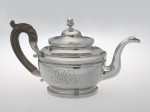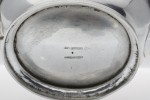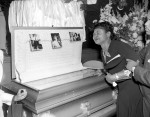 A teapot made by 19th century silversmith Peter Bentzon is the one millionth object digitized by the Smithsonian’s Mass Digitization Program. There are 154 million objects in the many collections of the Smithsonian Institute, so just 153 million more to go.
A teapot made by 19th century silversmith Peter Bentzon is the one millionth object digitized by the Smithsonian’s Mass Digitization Program. There are 154 million objects in the many collections of the Smithsonian Institute, so just 153 million more to go.
Peter Bentzon was born on the island of St Thomas in the Danish West Indies around 1783. The child of a free mulatto woman and a white father, he was what the Danish categorized as a “mustice” or “mustee.” His family was comparatively well-off; it is believed his father was Norwegian lawyer Jacob Bentzon who was a royal judge advocate on St Thomas for several years. Peter was sent to school in Philadelphia when he was eight years old, and was apprenticed to a Philadelphia silversmith in 1799 when he was 16. His completed his apprenticeship in 1806 and moved to Christiansted, St Croix, where he started his own silversmithing business.
 The British occupied the island from 1807 to 1816 which was advantageous for Bentzon because the British didn’t have the strict laws the Danish had controlling the movements, professions and political rights of the free coloured population of its colonies. Denmark reclaimed St Croix in 1816 and Bentzon made arrangements to move his family and business back to Philly. He lived and worked there until 1829, after which he returned to St. Croix for another 20 years. He relocated to Philadelphia again in 1848. His name is on the 1850 Census. After that, he disappears from the historical record. Wherever he was living, he regularly traveled back and forth between Philadelphia and St Croix.
The British occupied the island from 1807 to 1816 which was advantageous for Bentzon because the British didn’t have the strict laws the Danish had controlling the movements, professions and political rights of the free coloured population of its colonies. Denmark reclaimed St Croix in 1816 and Bentzon made arrangements to move his family and business back to Philly. He lived and worked there until 1829, after which he returned to St. Croix for another 20 years. He relocated to Philadelphia again in 1848. His name is on the 1850 Census. After that, he disappears from the historical record. Wherever he was living, he regularly traveled back and forth between Philadelphia and St Croix.
Bentzon was the only free silversmith of African descent in slavery-era America whose work can be identified from his hallmarks, P. BENTZON and PB. There were at least four other black silversmiths in Philadelphia during his time. Henry Bray and Anthony Sowerwalt are listed as silversmiths and “persons of color” in the 1813 and 1818 Philadelphia directories. Joseph Head and John Frances, a runaway slave, were also working as silversmiths. None of the four produced work under their own hallmark, however, so it’s impossible to link any surviving silver to them.
Very few of Bentzon’s pieces are known to have survived, fewer than three dozen, most of them teaspoons. That makes his work rarer than that of famed fellow silversmiths like Paul Revere and Thomas Fletcher. The Smithsonian’s teapot is the only one confirmed to have been made in Bentzon’s Philadelphia shop.
 The silver teapot is an oval vase-shape on a pedestal foot. The scroll handle is made of wood topped with a leaf design. The cover has an acorn finial. It is stamped twice on the bottom with Bentzon’s mark and is inscribed “Rebecca Dawson” on the base. Bentzon rented his workshop from a Robert Dawson, so perhaps Rebecca was a relative of his landlord. The monogram “MC” on the side is a later addition.
The silver teapot is an oval vase-shape on a pedestal foot. The scroll handle is made of wood topped with a leaf design. The cover has an acorn finial. It is stamped twice on the bottom with Bentzon’s mark and is inscribed “Rebecca Dawson” on the base. Bentzon rented his workshop from a Robert Dawson, so perhaps Rebecca was a relative of his landlord. The monogram “MC” on the side is a later addition.
It is in the collection of the Smithsonian’s National Museum of African American History and Culture (NMAAHC) which isn’t an actual museum yet. There had been efforts to create a national museum displaying art and artifacts from African-American history since 1915, but with little funding and no Congressional support, proposals went nowhere. A state initiative was more successful. The National Afro-American Museum & Cultural Center in Wilberforce, Ohio, received a federal charter from Congress in 1981 and opened in 1988 with no public funding. Its focus was more narrow than that envisioned for the national museum, however, with its main exhibition dedicated to the struggle for Civil Rights in the 1950s and others featuring the city of Wilberforce’s history as an important stop on the Underground Railroad and the founding of historically black college Wilberforce University, the first college in the United States that was owned and run by African Americans.
 The Smithsonian’s collection of African-Americana didn’t see much light until dedicated exhibitions in the National Museum of American History in the 1980s. For a long time the Board of the Smithsonian itself questioned whether the collection could sustain a stand-alone African-American history museum, and it wasn’t until December of 2003 that all the pieces came together with the passage of the National Museum of African American History and Culture Act establishing the new museum within the rubric of the Smithsonian Institution. It took another three years for the site, part of the Washington Monument grounds, to be selected. Settling on a design for the building took even more time. Finally, ground was broken on February 22nd, 2012.
The Smithsonian’s collection of African-Americana didn’t see much light until dedicated exhibitions in the National Museum of American History in the 1980s. For a long time the Board of the Smithsonian itself questioned whether the collection could sustain a stand-alone African-American history museum, and it wasn’t until December of 2003 that all the pieces came together with the passage of the National Museum of African American History and Culture Act establishing the new museum within the rubric of the Smithsonian Institution. It took another three years for the site, part of the Washington Monument grounds, to be selected. Settling on a design for the building took even more time. Finally, ground was broken on February 22nd, 2012.
Meanwhile, the Smithsonian took the innovative step of creating a virtual museum when the physical museum was still years away from construction. It created a website for the NMAAHC with select objects from the collection and online exhibitions. The first exhibition in the three dimensional world took place in New York in 2005. In 2012 the NMAAHC partnered with the Thomas Jefferson Foundation to put on an exhibition about slavery at Monticello held at the National Museum of American History.
 By 2015, the museum’s collection had grown to more than 33,000 objects including Louis Armstrong’s 1946 Selmer trumpet, 39 extremely rare Harriet Tubman artifacts donated in 2012 by collector Charles L. Blockson, Emmett Till’s glass-topped casket, a 1922 Pullman railroad car from Chattanooga, Tennessee, used to carry Black passengers under Jim Crow segregation and a guard tower from Louisiana’s notorious Angola penitentiary which was so big the museum had to be build around it.
By 2015, the museum’s collection had grown to more than 33,000 objects including Louis Armstrong’s 1946 Selmer trumpet, 39 extremely rare Harriet Tubman artifacts donated in 2012 by collector Charles L. Blockson, Emmett Till’s glass-topped casket, a 1922 Pullman railroad car from Chattanooga, Tennessee, used to carry Black passengers under Jim Crow segregation and a guard tower from Louisiana’s notorious Angola penitentiary which was so big the museum had to be build around it.
The National Museum of African American History and Culture will opens its doors in the new building on September 24th, 2016.